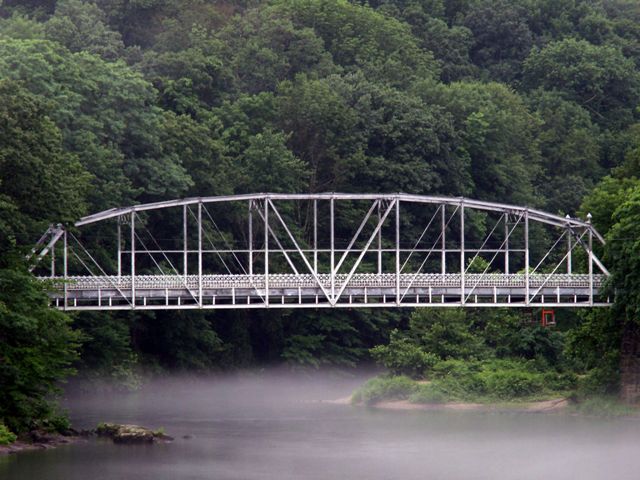We Recommend:
Bach Steel - Experts at historic truss bridge restoration.
BridgeHunter.com Phase 1 is released to the public! - Visit Now
Town Bridge Road Bridge

Primary Photographer(s): Nathan Holth and Rick McOmber
Bridge Documented: July 13, 2008
Rural: Hartford County, Connecticut: United States
1895 By Builder/Contractor: Berlin Iron Bridge Company of East Berlin, Connecticut
1989
160.0 Feet (48.8 Meters)
172.0 Feet (52.4 Meters)
14.4 Feet (4.39 Meters)
1 Main Span(s)
5222

View Information About HSR Ratings
Bridge Documentation
This bridge is in storage!
Bridge Status: April 2019: Bridge is temporarily dismantled as part of a comprehensive rehabilitation project. It will be erected here again once shop repairs are done.View Archived National Bridge Inventory Report - Has Additional Details and Evaluation
This bridge is an extremely rare and important bridge. It is a bridge built by the famous Berlin Iron Bridge Company of East Berlin, Connecticut. What is interesting about the historic significance and rarity of this bridge is the following: because this bridge has a more common truss configuration than it might have had, it is very important. That is because its builder almost exclusively built lenticular truss bridges during the period in which the Town Bridge Road Bridge was built. Lenticular truss bridges are a very rare and distinctive type of truss configuration that is very significant. However, as a more common truss type, the Parker truss, the Town Bridge Road Bridge is also extremely significant for being a Berlin Iron Bridge structure that is anything other than a lenticular bridge. It is interesting to draw comparisons to the lenticular truss bridges to learn more about the Berlin Iron Bridge Company. Even though this bridge is a Parker truss, it still has some of the details seen on the company's lenticular truss bridges, including the company's distinctive ornate railings, decoration (cresting) on the portal bracing, and decorative finials.
Information and Findings From Connecticut's Historic Bridge Management PlanDiscussion of Bridge BRIDGE NO. 5222: Town Bridge Road over Farmington River, Canton Description: 1895, wrought-iron Parker through truss, 1 span, pin connected; built by Berlin Iron Bridge Co.; extensive portal ornament (cresting and finials). Similar Structures in Preservation Plan: none Historical Significance: Besides being one of the few 19th-centurywrought-iron trusses to survive in the state, it exhibits the range of work undertaken by Berlin Iron Bridge Co., beyond the lenticular trusses for which the firm is famous. Preservation Planning: General Considerations: The town has recently rehabilitated the bridge, including installation of a new corrugated-deck floor system, the patching of numerous members, and attachment of new W-rail roadway barriers inside the truss webs. Apparently, therefore, the archaic width and alignment, and the vertical clearance of less than 13', are not considered to be serious problems for the crossing. Nearby alternate crossings are available both upstream and downstream. Structural Rehabilitation: Continued welding of patch plates will eventually compromise the historic integrity and appearance of the bridge. Replacement of members with like components in steel should be considered if load capacity becomes a concern; again, extensive replacement would compromise the historic integrity. Bypass: The lack of nearby buildings would appear to make this a viable option. |
![]()
Photo Galleries and Videos: Town Bridge Road Bridge
Bridge Photo-Documentation
Original / Full Size PhotosA collection of overview and detail photos. This gallery offers photos in the highest available resolution and file size in a touch-friendly popup viewer.
Alternatively, Browse Without Using Viewer
![]()
Bridge Photo-Documentation
Mobile Optimized PhotosA collection of overview and detail photos. This gallery features data-friendly, fast-loading photos in a touch-friendly popup viewer.
Alternatively, Browse Without Using Viewer
![]()
Maps and Links: Town Bridge Road Bridge
Coordinates (Latitude, Longitude):
Search For Additional Bridge Listings:
Bridgehunter.com: View listed bridges within 0.5 miles (0.8 kilometers) of this bridge.
Bridgehunter.com: View listed bridges within 10 miles (16 kilometers) of this bridge.
Additional Maps:
Google Streetview (If Available)
GeoHack (Additional Links and Coordinates)
Apple Maps (Via DuckDuckGo Search)
Apple Maps (Apple devices only)
Android: Open Location In Your Map or GPS App
Flickr Gallery (Find Nearby Photos)
Wikimedia Commons (Find Nearby Photos)
Directions Via Sygic For Android
Directions Via Sygic For iOS and Android Dolphin Browser
USGS National Map (United States Only)
Historical USGS Topo Maps (United States Only)
Historic Aerials (United States Only)
CalTopo Maps (United States Only)


